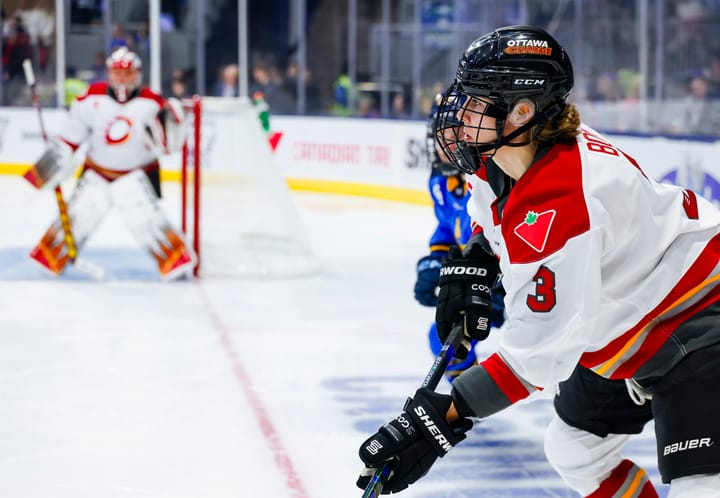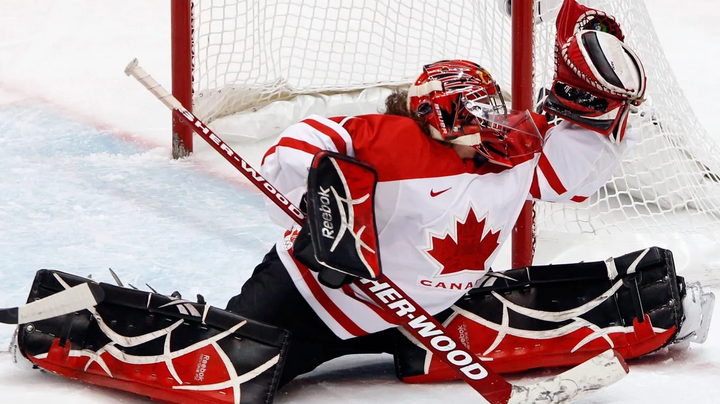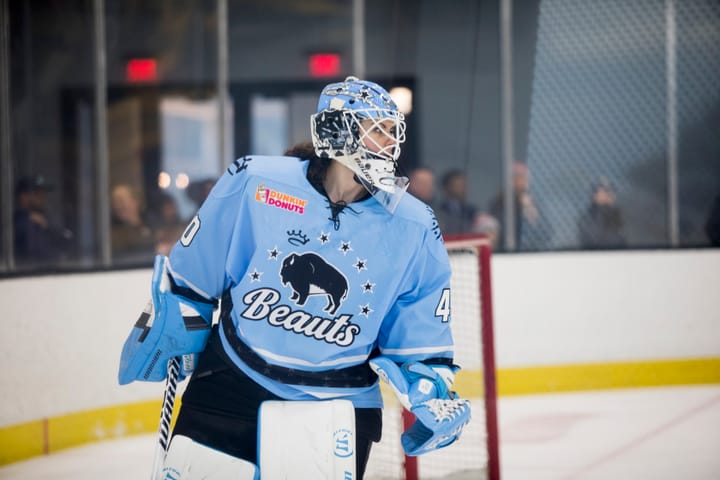Video Breakdown: The Minnesota Whitecaps’ Power Play
How Sydney Baldwin and others featured on the Whitecaps lethal advantage in Lake Placid
The Minnesota Whitecaps finished Lake Placid with a league-best 26.3 percent power-play success rate. Even in a scant four-game sample size, that’s quite good. That success rate is even more noteworthy because the Whitecaps, who finished with a record of 3-1-0, scored five of their 11 goals on the power play. In Lake Placid, the reigning Isobel Cup champions were living and dying by their goaltending and special teams play.
We should always hesitate before we read too much into data from small sample sizes but that doesn’t mean we can’t learn things from them. We can identify trends in Minnesota’s 19 power-play opportunities that led to the team being successful on the advantage in four games. We can be skeptical about these trends but they obviously made an impact due to the brevity of the tournament.
Was this a “good” power play or perhaps just a “hot” one? Perhaps a bit of both? I’ll leave that for you to decide. I should also note that I’m not an expert in hockey tactics or a coach. These are just my thoughts and observations based on what we saw in Lake Placid.
Let’s start with the players who were on the ice when the Whitecaps were on the power play and how Minnesota’s coaching staff put them in a position to succeed.
Deployment and Strategy
Heading into Lake Placid, one might have thought that it was a given that the Whitecaps’ biggest guns — All-Star forwards Allie Thunstrom and Jonna Curtis — would be on the top power-play unit. But that was not necessarily the case.
The top skaters in average power-play ice time (PP TOI/GP) for Minnesota were Stephanie Anderson (3:48), Haley Mack (3:45), Sydney Baldwin (3:41), Meghan Lorence (3:28), and Nina Rodgers (2:33). That group of five averaged 2:17 PP TOI/GP. The fivesome of Emma Stauber, Maddie Rowe, Meaghan Pezon, Thunstrom, and Curtis was the second-most deployed PP unit (1:48 PP TOI/GP). The third-most deployed unit was the same as the first but with Audra Richards in Rodgers’ role in the first game on Jan. 23.
As it turns out, Thunstrom and Curtis led all Whitecaps’ forwards in average shorthanded ice time per-game; 4:33 and 4:03, respectively. So, there’s a chance that Whitecaps coaches Jack Brodt and Laura Slominski opted to keep the pair of All-Stars off the top power-play unit so they could kill penalties as a dangerous shorthanded forward duo.
Although teams frequently adapt on the fly during games and improvise, especially on the power play, the Whitecaps’ top unit primarily used a 1-3-1 formation on the advantage in Lake Placid. The second unit relied a lot on the 1-3-1 and Umbrella formations, with Pezon, Thunstrom, and Curtis — Minnesota’s high-scoring top line from the 2019-20 season — cycling and making plays and Stauber and Rowe serving as outlets.
Here’s Minnesota’s second PP unit in action. Note where Pezon (#15), Rowe (#33), and Stauber (#7) are when the power play resets, forming an umbrella high in the offensive zone before Stauber drifts down to the right faceoff circle for the 1-3-1. On this play, Pezon takes a shot that turns into a prime scoring opportunity for Stauber, who crept in for the backdoor play and pounced on the rebound, but the puck was on edge and she sent it wide.
The 1-3-1 is a formation we see a lot of in elite levels of hockey because it creates a lot of options and it's adaptable. However, it does require you to have a lot of faith in the lone player on the blue line. Ryan Stimson discussed the advantages of the 1-3-1 and other PP formations in a series about hockey systems for The Athletic in 2018. Here’s an excerpt from that story:
It puts a lot of pressure on the penalty killing team due to all the triangles that can be created off of the default setup, but also new ones that can be created by a simple low release play by the Net Player.
The idea with the 1-3-1 is to create triangles around outnumbered penalty killers which means creating options for skilled players. You have two players on the boards who have passing and shooting lanes, a “bumper” in the slot to be a target and create problems in the high slot, a net player to screen the goalie and drift out to become a passing option below or on the goal line, and the player on the point.
The player on the point needs to have great vision and exceptional puck skills. Because if they mishandle the puck or make a poor decision, the penalty killers won’t have much to stop them from going the other way.
You can probably guess who that player was for the Whitecaps.
Baldwin’s Impact
In many ways, the Whitecaps power play was the Sydney Baldwin show. She pulled all the strings for the first unit, as evidenced by the number of touches and shot attempts she had.
Consider the fact that Baldwin attempted 16 of the Whitecaps’ 50 shot attempts on the power play — that’s nearly one-third of all shots. She also shared the team lead in PP passes with Meghan Lorence (27), who frequently set up on the boards as another playmaker for the Whitecaps.
Even more interesting is that only a few of Baldwin’s shots on the PP were slap shots. More often than not, she opted for wristers taken while there was traffic in front of the net, knowing that she had talented forwards like Mack, Lorence, Rodgers, and Anderson prowling for rebounds.
Note: an “X” is a missed or blocked shot, a circle is a shot on goal, a red circle is a goal.
Here’s a great example of the Whitecaps running the power play through Baldwin and relying on her vision and decision-making to make things happen — this also happens to be the sequence where she scores her power-play goal. How did she score? A wrister that found its way through traffic.
Watch Baldwin quickly survey where the penalty killers are before receiving the puck from Rodgers, who is set up on the boards, before firing a low wrister into traffic. Her first shot is blocked but it’s quickly collected in the corner by Stephanie Anderson with some help from Rodgers. From there, Anderson moves the puck to Lorence who nearly sets up Mack for a goal right on top of the crease. Toronto fails to clear the puck after that chance and Rodgers gets it back to the point to Baldwin, who puts another low wrister into traffic and into the back of the net.
About 15 seconds separate Baldwin’s shot attempts and Mack’s scoring chance splits that difference. Two shot attempts and a scoring chance in 15 seconds that demonstrate creativity, chemistry, good puck movement, and just how crucial Baldwin was to Minnesota’s power play. All these shots from the point were more about volume than quality but don’t overlook how valuable it is to take away a goalie’s eyes or force them to make a first save when you can outnumber defending players around the net.
The Top Unit
As fantastic as Baldwin was, success on the power play never comes down to one player being magnificent. You need all five (or four) players to play their role, make good reads, and make plays. Two other Whitecaps who really shined on the top unit were the two forwards who shared the team lead in PP scoring — Meghan Lorence and Nina Rodgers.
As mentioned earlier, Lorence saw a lot of the puck on the top unit. She also led the Whitecaps’ power play in puck entries by stickhandling (4) so you could say that more often than not she got things set up. Lorence was definitely a pass-first player, attempting just four shots compared to 27 passes — 23 of which were accurate, per InStat’s tracking. She had three assists on the advantage, two of which were secondary assists on Rodgers’ pair of power-play goals.
Like Baldwin, Rodgers had no qualms about being a triggerwoman for Minnesota on the power play. She attempted seven shots, two of which ended up in the back of the net — both scored on Jan. 30 against the Toronto Six. For the most part, she played along the boards, opposite of Lorence. You can get an idea of where her “office” was on the PP from this shot map.
The contributions of Stephanie Anderson and Haley Mack also shouldn’t be overlooked. Anderson really excelled as the bumper and as a net-front presence, using her 5-foot-9 frame to create traffic and get to pucks. Mack made a lot of crafty plays, including her game-winning goal scored on a 5-on-3 opportunity with 10 seconds left in regulation against the Riveters. In total, Anderson and Mack led the top PP unit in scoring chances with three each. Clearly, they were making things happen.
Pezon, Stauber, and the Second Unit
We saw a lot less of the Whitecaps’ second power-play unit but make no mistake, it also looked really good. Meaghan Pezon, in particular, was making a lot of things happen. She led the second unit with six shot attempts and 24 passes — every one of which found its intended target. It’s also worth noting that Pezon had three scoring chances despite seeing less ice time on the man advantage.
Pezon scored her power-play goal on a 5-on-3 in Minnesota’s unforgettable comeback win over the Six on Jan. 24. Take note of where Emma Stauber (left point) and Maddie Rowe (right point) are here. Minnesota went with a Spread (a reverse Umbrella) to outnumber the Six’s penalty killers around the net. And it worked.
Stauber’s contributions to the second unit were also pretty significant, especially considering her well-earned reputation as a defense-first defender. She entered the zone four times via stickhandling and had four breakouts to lead all skaters on that second unit. For some context, Baldwin led all of Minnesota’s PP skaters with eight breakouts. Stauber also attempted the third-most amount of passes on the second unit (19), behind Pezon (24) and Jonna Curtis (21).
Generally speaking, the second unit was a little less one-dimensional than the first unit — but it’s hard to make a firm statement like that with this sample size. Pezon and Curtis were the big playmakers and Pezon (3) and Thunstrom (2) were the main targets, as evidenced by their scoring chances. There was a lot more cycling and a lot less offense coming from the point, as we saw on the first unit with Baldwin at the top of the 1-3-1. You can get a sense of this by looking at the shot charts of both units.
The bottom line is that both of the Whitecaps’ power-play units had success and looked good through four games of hockey. The key to Minnesota’s success on the advantage comes down to having an exceptional puck-moving defender in Sydney Baldwin and a deep group of forwards who thrived when they had time and space to work with.
The fact that the Whitecaps found this level of success on the power-play without All-Star defender Amanda Boulier and premier power forward Corinne Buie — who is still tied for fourth all-time in NWHL power-play scoring (15) — in the lineup speaks volumes about just how much skill was in Minnesota’s lineup in Lake Placid.
All data courtesy of InStat, NWHL.zone, and HerHockeyCounts.com
Want to know more about hockey tactics? I encourage you to check out Tape to Space: Redefining Modern Hockey Tactics by Ryan Stimson.





Comments ()